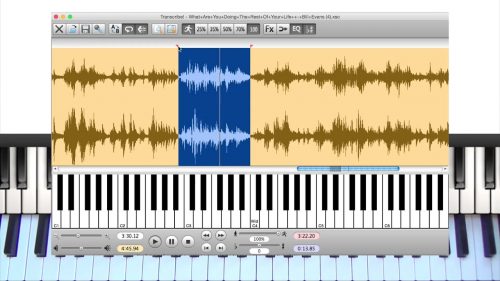Ear Training & Transcription
In this 5 minute masterclass we’re going to talk about transcribing and ear training.
The basis of learning music and especially improvised music is to have a good relative ear; to be able to recognise different intervals, melodies and harmonic concepts by ear.
The Importance Of Transcription
Transcribing is the only ear training you need, as you will simultaneously develop your ear AND learn the language.
If you feel like transcribing from records is too difficult, in this lesson we’re going to give you tools that will make transcribing easier.
Recognising Different Intervals
When practicing interval training, find a song that you remember that has the interval you want to learn to hear. In the lesson we will demonstrate this with the theme song from the movie Mary And Max, and also the theme song from Simpsons.
You can of course pick any tune you remember well and you can apply this to all intervals.
How To Transcribe Phrases & Melodies
I would recommend to take something medium tempo and easy to hear. First, try to hear where the phrase starts, and where it ends. Then try to find all already familiar things within the melody, for example the major triad in the middle
How To Transcribe Chords
For transcribing chords, all the things I mentioned apply – in particular recognising the intervals. With chords it’s important to hear the movement of the chord tones, for example let’s take a simple cadenza 36251 with some tensions in the key of C.
First, I would try to hear the chords main function. Second, I would try to hear the highest and the lowest note. After I get that, then it’s time for the inner voices, which usually are moving only half or whole step at a time.
Practice Tips
-
Recognising major 3rd from minor 3rd and Major 7th from flat 7 is crucial for further progress.
-
When transcribing lines, first find the starting note and the ending note. Then work out what's in between.
-
When transcribing chords, first work out the chord qualities/functions by listening for the 3rds and 7ths.
-
Next try to hear the highest and lowest note of the chord.
- Finally work out the inner voices which typically move in half or whole steps.







Hi Tuomo, I have a question about the chord progression in the cadenza 36251. The 6th and 2nd are both Dominant chords, why is that ? I thought that in the key of C, a 2nd would be Dmin7, and a 6th would be an Amin 7. Could you enlighten me ? Thanks for a great video.
Hi Natasha, great question! Here’s a pdf. that should help. The thing with 36251 is that you have lots of possibilities to reharmonize, the ones on the sheet are basic dominant reharms, a good place to start. Please let me know if you have any further questions or ideas! All the best, -Tuomo
Thank you Tuomo, this is most helpful. I shall now practice it in all 12 keys :) Cheers
I’m glad to help! Also check out my new weekly improvisation/ear training exercises on PianoGroove Community! Cheers, -Tuomo
Hello Tuomo. I can only see the first 1 minute of this lesson recording. While I have an annual subscription plan, I am told “upgrade your plan to watch this tutorial”! I thought I had access to all the lessons. Pls help.
HI Dilara,
I will fix this for you now.
Apologies for the inconvenience… it is a technical issue.
I will send you a message shortly.
Cheers,
Hayden